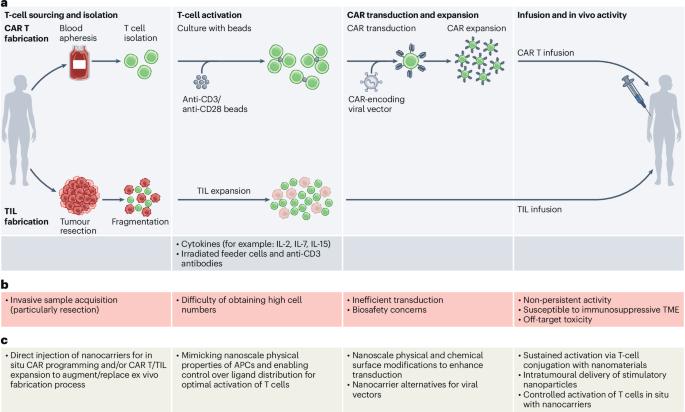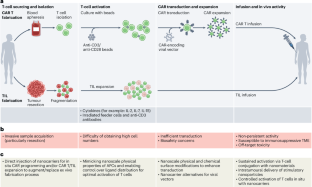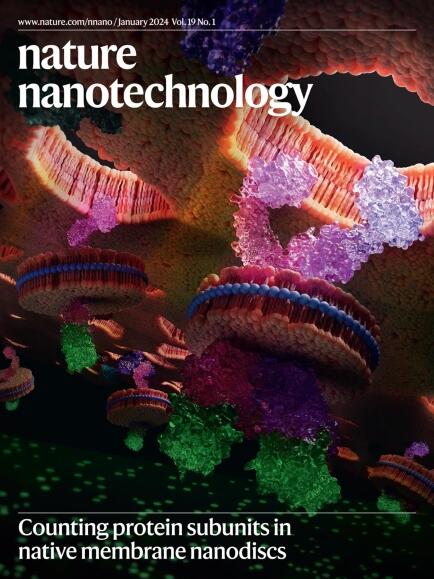纳米技术用于CAR - T细胞和肿瘤浸润淋巴细胞治疗
IF 34.9
1区 材料科学
Q1 MATERIALS SCIENCE, MULTIDISCIPLINARY
引用次数: 0
摘要
过继性T细胞疗法,特别是CAR - T细胞和肿瘤浸润淋巴细胞,通过选择性靶向恶性细胞,已经改变了癌症治疗。尽管取得了临床成功,但这些疗法面临着巨大的挑战,包括昂贵的制造过程和肿瘤施加的障碍,这些障碍限制了疗效。在了解控制t细胞活化的纳米级机制和肿瘤微环境在限制t细胞反应中的作用方面取得的进展,推动了基于纳米技术的整合关键化学和物理线索的策略的发展。在这里,我们简要概述了CAR - T和肿瘤浸润性淋巴细胞治疗的现状,并讨论了纳米技术策略,以提高它们的体外生产、体内性能和CAR - T细胞的直接体内生成。我们强调纳米技术的变革潜力,克服现有的挑战,扩大治疗应用,并确定将塑造未来纳米技术用于CAR - T和肿瘤浸润性淋巴细胞治疗的因素。本文章由计算机程序翻译,如有差异,请以英文原文为准。


Nanotechnology for CAR T cells and tumour-infiltrating lymphocyte therapies
Adoptive T-cell therapies, and particularly CAR T cells and tumour-infiltrating lymphocytes, have transformed cancer treatment by selectively targeting malignant cells. Despite their clinical success, these therapies face substantial challenges, including costly manufacturing processes and tumour-imposed barriers that limit efficacy. Advances in understanding the nanoscale mechanisms governing T-cell activation and the role of the tumour microenvironment in restricting T-cell responses have driven the development of nanotechnology-based strategies that integrate key chemical and physical cues. Here we provide a brief overview of the current state of CAR T and tumour-infiltrating lymphocyte therapies and discuss nanotechnology strategies to enhance their ex vivo production, in vivo performance and the direct in vivo generation of CAR T cells. We highlight nanotechnology’s transformative potential to overcome existing challenges, broaden therapeutic applications and identify factors that will shape the future of nanotechnology for CAR T and tumour-infiltrating lymphocyte therapies. This Review analyses how nanotechnology is poised to make cell therapies like CAR T and tumour-infiltrating lymphocytes more effective and accessible, and the challenges that this entails.
求助全文
通过发布文献求助,成功后即可免费获取论文全文。
去求助
来源期刊

Nature nanotechnology
工程技术-材料科学:综合
CiteScore
59.70
自引率
0.80%
发文量
196
审稿时长
4-8 weeks
期刊介绍:
Nature Nanotechnology is a prestigious journal that publishes high-quality papers in various areas of nanoscience and nanotechnology. The journal focuses on the design, characterization, and production of structures, devices, and systems that manipulate and control materials at atomic, molecular, and macromolecular scales. It encompasses both bottom-up and top-down approaches, as well as their combinations.
Furthermore, Nature Nanotechnology fosters the exchange of ideas among researchers from diverse disciplines such as chemistry, physics, material science, biomedical research, engineering, and more. It promotes collaboration at the forefront of this multidisciplinary field. The journal covers a wide range of topics, from fundamental research in physics, chemistry, and biology, including computational work and simulations, to the development of innovative devices and technologies for various industrial sectors such as information technology, medicine, manufacturing, high-performance materials, energy, and environmental technologies. It includes coverage of organic, inorganic, and hybrid materials.
 求助内容:
求助内容: 应助结果提醒方式:
应助结果提醒方式:


